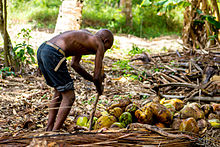Tanzania's economy
The economy of Tanzania is that of an agrarian developing country with a low level of development.
In Tanzania , the gross domestic product per capita is very low, so that the country is partly dependent on official development aid. In 2005, this was US $ 40 per capita. The economic situation is also burdened by the influx of refugees from the neighboring countries Rwanda and Burundi .
The situation has improved in recent years and Tanzania is now one of the fastest growing economies in Africa and the world. Since 2000 the gross domestic product has more than tripled. The country benefits from increasing economic integration into the East African Community , raw material deposits, relative political stability and a favorable location on the Indian Ocean .
Agriculture
Agriculture is an important branch of the economy in which more than 75% of the workforce is employed. At the same time, agriculture contributes more than 30% to the gross domestic product. Land change farming is predominant in Tanzania . Subsistence farming is widespread , where millet , cassava , yams , sweet potatoes and legumes are grown. Other very important crops are rice , corn , tea , sisal , cotton , tobacco , wheat , bananas , coconut palms and coffee . In livestock husbandry, the keeping of cattle dominates . A total of around 15 million are kept in Tanzania. Sheep , goats and chickens are kept for personal use . However, Tanzania's soil is endangered by desertification , and the possibilities for combating it are given as very low. In addition, the soil is severely damaged by runoff.
Natural resources and industry
The country has rich natural resources . These include natural gas , gold (e.g. from the Geita opencast mine ) and diamonds . The industry in Tanzania is poorly developed and is limited to the food industry and petroleum refineries.
tourism
Tourism is an important economic sector that accounts for over 30 percent of export earnings. The north of Tanzania and the coastal areas are well developed for tourism. The Serengeti National Park, Ngorongoro and Kilimanjaro are important .
Key figures
All values are given in US dollars ( purchasing power parity ).
| year |
GDP (purchasing power parity) |
GDP per capita (purchasing power parity) |
GDP growth per year |
|---|---|---|---|
| 1980 | 11.0 billion | 591 | 3.3% |
| 1985 | 15.9 billion | 742 | 4.6% |
| 1990 | 24.3 billion | 981 | 7.0% |
| 1995 | 29.9 billion | 1,040 | 3.8% |
| 2000 | 40.1 billion | 1,223 | 4.9% |
| 2005 | 62.0 billion | 1,650 | 6.5% |
| 2010 | 91.7 billion | 2.141 | 6.4% |
| 2011 | 101.0 billion | 2,301 | 7.9% |
| 2012 | 108.1 billion | 2,407 | 5.1% |
| 2013 | 117.9 billion | 2,572 | 7.3% |
| 2014 | 128.3 billion | 2,745 | 7.0% |
| 2015 | 138.7 billion | 2,910 | 7.0% |
| 2016 | 150.3 billion | 3,087 | 7.0% |
| 2017 | 162.2 billion | 3,240 | 6.0% |
See also
Web links
- Link catalog on Tanzania's economy at curlie.org (formerly DMOZ ) (English)
- ÖFSE - Country Profile Tanzania Report on Economy and Development Aid (PDF file; 227 kB)
Individual evidence
- ^ Report for Selected Countries and Subjects. Retrieved August 21, 2018 (American English).
